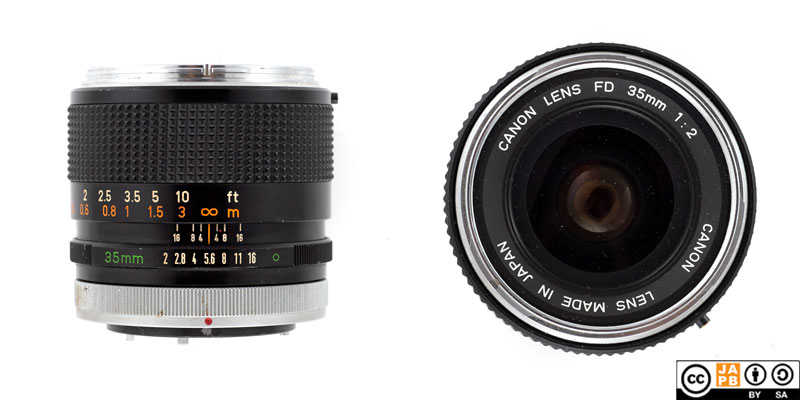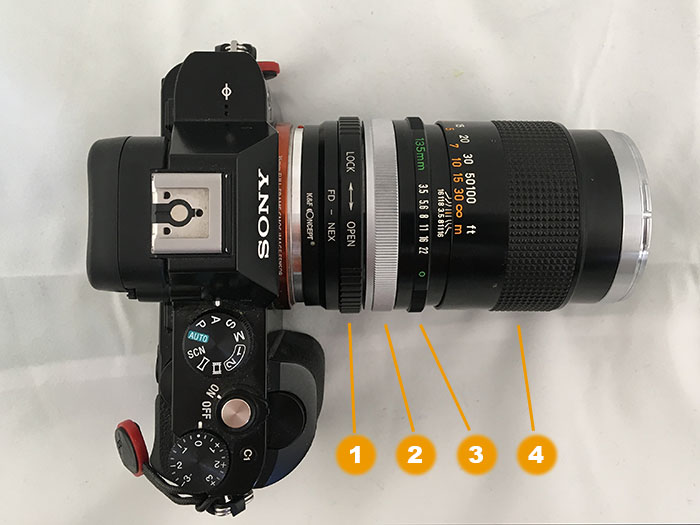Pekka Buttler, 08/2022(Updated 08/2023)
Note: This lens participated in a JAPB comparison review of fast 35 mm lenses.

Specifications
The table below summarizes the lens’ key specifications:
| Brand: | Canon | Lens name | FD 35mm 1:2 |
| Focal length 1 | 35 mm | Angle-of-view 2 | 62° |
| Maximum Aperture | f/2 | In Production | 1971–1973 |
| Lens mount | Canon FD | Subfamily (if applicable) | FD (chrome nose) |
| Length 3 | 62,4 mm | Diameter 4 | 66,7 mm |
| Filter ring diameter | 55 mm | Weight | 511 grams |
| Lens element count | 9 | Lens group count | 8 |
| Aperture blades (S/R/C) 5 | 8 S | Focus throw | 175 ° |
| Minimum focusing distance | 30 cms | Maximum magnification | 1:6,4 |
| Has manual aperture ring | YES | Has Manual focus ring | YES |
| Aperture mechanism type | Automatic | Aperture click stops 6 | 2•2.8•4•5.6•8•11•16 |
Further notes:
The original (1971) Canon FD lineup featured an impressive lineup of wide-angle lenses, including:
• Canon FD 17 mm f/4 7
• Canon FD 24 mm f/2.8 ‘chrome nose’ [data sheet]
• Canon FD 28 mm f/3.5 ‘chrome nose’ [data sheet]
• Canon FD 35 mm f/2 ‘chrome nose’ [this lens]
• Canon FD 35 mm f/3.5 ‘chrome nose’ [data sheet]
• These lenses were all replaced in 1973 with modernised versions that changed bayonet mount for lens hoods from a chromed to a black-painted and included an acronym (S.C. or S.S.C.) to indicate the coating technology.
• The genealogy of the Canon FD 35/2 is more convoluted than with most lenses, and information found online is contradictory (and some is plain wrong).
• What is known that at least 6 different versions of the FD 35/2 were made; that the first three versions were made as chrome nose variants with a concave front element and thoriated (radioactive) lens elements (but sources are not clear on what was changed between these three versions); that a fourth version was made that is no longer chrome nosed, but still has the concave front element and proclaims it has S.S.C coatings (but at least the third version seems to have these coatings too, but does not say so); that the fifth version no longer has the concave front element and is otherwise redesigned (but still is in vanilla FD mount), while the sixth version is in new FD (FDn) mount, 100 grams lighter and has a significantly smaller front element.
• The sample measured for this data sheet has a serial number of 25***, and should therefore belong to the last series of chrome nose FD 35/2’s, but its weight is surprising. This lens measures at 511 grams, while Canon maintains that their heaviest ever 35/2 weighed 420 grams.
• Alike most Canon FD lenses, the lens front sports both a filter ring (55 mm) as well as grooves for mounting a bayonet-type lens hood.
• The BW-55A is the dedicated lens hood for this lens.
The history of Canon FD chrome nose lenses
Canon is undoubtedly one of the great names in 35 mm SLR photography. Ever since the 1959 introduction of the Canonflex – Canon’s first interchangeable lens SLR – Canon has constantly focused on being at the forefront of Camera innovation. Often this has necessitated taking stock and redesigning both cameras, lenses and lens mounts. Unlike its archival Nikon, Canon has not tried to integrate all novel features in the same lens mount, but has instead repeatedly launched new, modified mounts to facilitate new features, while still often (but not always) managing to maintain a decent degree of backwards compatibility.
In short (a longer version is here), the development of Canon SLR mounts can be traced as follows:
• 1959–1963: R-mount 8. Canon’s first SLR lens mount. Breech lock-type mount with aperture automation (camera is able to stop down lens for taking the shot.
• 1964–1969: FL-mount. Breech-lock type mount, physically similar mount as Canon R-mount, but camera-to-lens communication linkages somewhat different. Cannot communicate selected aperture to body (stop-down-metering only).
• 1970–1978: FD-mount. Breech-lock mount. FD lenses compatible with FL-cameras and vice versa. Manual focus lenses that communicate aperture information to camera, hence opening the door for automatic exposure (both shutter priority and aperture priority possible)
• 1979–1986: new FD-mount (a.k.a. FDn). Bayonet mount, backwards compatible with FL and FD mounts. Otherwise, as FD mount.
• 1987–today: EF-mount. Electronically controlled autofocus lenses that use an internal focusing motor. Compatible with previous mount lenses only using an adapter with optics.
‘Chrome nose‘ lenses are a characteristic of the early days of the Canon FD mount, as the first lenses to be introduced used chrome-plated filter ring/hood mount. Many chrome nose lenses are mechanically and optically identical to later Canon FD lenses, but:
• there are cases where Canon redesigned the lens significantly when going from chrome nose to normal FD,
• a chrome nose Canon FD lens is an easy-to-see guarantee for a very early (early 1970s) Canon FD lens, hence virtually guaranteeing that the optical coatings are not the most modern, and
• chrome nose lenses are visually easy to distinguish, and some like their looks.
Interestingly, when Canon introduced the FD mount and its lineup of lenses, not all lenses introduced early on sported a chrome nose. Also there are some cases where Canon marketing material showed a specific lens with a chrome nose, only to never have been seen since. I have personally seen the following lenses as chrome nose models: 24/2.8; 28/3.5; 35/2; 35/3.5; 50/1.4; 50/1.8; 55/1.2; 55/1.2 AL; 100/2.8, and 135/3.5.
Related versions
Canon has a long history of manufacturing f/2 35 mm lenses, that can be summarised (based on data from the Canon camera museum) as:
• FD 35 mm f/2 chrome nose (I) (1971–1971), 9 elements in 8 groups, 55 mm filter, 8 blades, 420 grams (concave front lens surface)
• FD 35 mm f/2 chrome nose (II) (1971–1973), 9 elements in 8 groups, 55 mm filter, 8 blades, 420 grams (concave front lens surface)
• FD 35 mm f/2 chrome nose (III) (1973–1973), 9 elements in 8 groups, 55 mm filter, 8 blades, 420 grams (concave front lens surface) [this lens] 9
• FD 35 mm f/2 ‘S.S.C’ (I) (1973–1976), 9 elements in 8 groups, 55 mm filter, 8 blades, 370 grams (concave front lens surface)
• FD 35 mm f/2 ‘S.S.C’ (II) (1976–1979), 9 elements in 8 groups, 55 mm filter, 8 blades, 345 grams (convex front lens surface)
• FDn 35 mm f/2 (1979–1993 10), 10 elements in 8 groups, 55 mm filter, 8 blades, 245 grams (convex front lens surface)
• EF 35 mm f/2 (1990–2012), 7 elements in 5 groups, 52 mm filter, 5 blades, 210 grams [data sheet]
• EF 35 mm f/2 IS USM (2012–), 10 elements in 8 groups, 67 mm filter, 8 blades, 335 grams
Adapting
n.B! As chrome nose lenses are 100% Canon FD lenses, the following applies to all Canon FD lenses:
This lens cannot be used natively on any current SLR or dSLRs. To use it in its native environment, you will need a Canon FD-mount film body. I’ve personally shot my chrome nose 50/1.4 on a Canon F-1 to great effect.
Thanks to being a fully manual lens (manual aperture, manual focus), the lens can be adapted to all mirrorless cameras using a suitable adapter. However, for the adapter to allow the lens to stop down, you will need an adapter that can be set to engage the FD lens’ aperture control lever. Personally, this is my biggest gripe with the FD-mounts as this leads to what I refer to as the four-ring problem:

[1] Activation ring for aperture control
[2] Locking ring for breech-lock mount
[3] Aperture ring
[4] Focus ring
Note, that especially the first three rings are very close together.
Moreover, a large range of special adapters (helicoid adapters, tilt/shift adapters, speed boosters) for using Canon FD lenses on most mirrorless systems are available.
Using Canon FD lenses on dSLRs is a possibility, but is not problem free. Thanks to the relatively short flange focal distance of the Canon FD mount (at 42,0 mm, clearly shorter than that of any full-frame dSLR mount), any adapter will necessitate some optics to achieve infinity focus.
Footnotes
- Focal length is (unless stated otherwise) given in absolute terms, and not in Full-frame equivalent. For an understanding of whether the lens is wide/tele, see ‘Angle-of-view’. ↩︎
- Picture angle is given in degrees and concerns the diagonal picture angle. Rule of thumb:
> 90 ° ==> Ultra-wide-angle
70–90 ° ==> Wide-angle
50–70 ° ==> Moderate wide-angle
40–50 ° ==> ‘Standard’ or ‘normal’ lens
20–40 ° ==> Short tele lens
10-20 ° ==> Tele lens
5-10 ° ==> Long tele lens
< 5 ° ==> Ultra-tele lens ↩︎ - Length is given from the mount flange to the front of lens at infinity. ↩︎
- Diameter excludes protrusions such as rabbit ears or stop-down levers. ↩︎
- S=straight; R=rounded; C=(almost)circular at all apertures. ↩︎
- Numbers equal aperture values on aperture ring; • intermediate click; – no intermediate click. ↩︎
- The early Canon FD 17 mm f/4 lens did not have a chrome nose. The ‘chrome nose’ was a chromed bayonet-mount for using lens hoods. The FD 17/4 did not support a bayonet mounted lens hood, and hence no Canon FD 17/4 with a chromed front exists.
However the first generation of the 17/4 (1971–1973) can easily be distinguished from the second version (1973–1979) because the first version carries its name inside the filter ring (on the lens front) whereas the second version carries its name (including S.S.C acronym) on the filter ring’s outside. ↩︎ - The Canon-R mount should possibly be renamed to (or referred to) as the Canonflex mount to avoid confusion with the modern mirrorless mount that is sometimes also referred to as the Canon R mount. ↩︎
- According to some sources, the best way of identifying these ‘chrome nose versions’ are the serial numbers:
Version I: 10000–12199
Version II: 12200–20000
Version III: 20001– (The 1st S.S.C version starts at 50000) ↩︎ - While Canon had launched the EF cameras and lenses in 1987, manufacture of both FD bodies and lenses did continue. The date given here (1993) is based on the last date code I was able to find on eBay. ↩︎